Spatiotemporal Evolution of Urban Resilience and Spatial Spillover Effects in Guangdong Province, China
Abstract
:1. Introduction
2. Study Area and Data Sources
2.1. Study Area
2.2. Data Sources and Process
3. Methodology
3.1. Urban Resilience Measurement Model
3.1.1. Indicator Selection
3.1.2. Indicator Weight Calculation
3.1.3. Urban Resilience Calculation
3.2. Getis-Ord Gi* Model
3.3. Improved Capello Model
3.4. Optimal-Parameters Geographical Detector (OPGD)
4. Results and Analysis
4.1. Spatiotemporal Evolution of Urban Resilience
4.1.1. Temporal Evolution of Urban Resilience
4.1.2. Spatial Evolution of Urban Resilience
4.2. Analysis of the Spillover Effect of Urban Resilience
4.2.1. Spatial Spillover Structure of Urban Resilience
4.2.2. Spatial Distribution Characteristics of Urban Resilience Spillover Intensity
4.3. Driving Factors of Urban Resilience
5. Discussion
5.1. Comparative Analysis of Regional Urban Resilience Characteristics
5.2. Implications of Spatial Spillover of Urban Resilience for Metropolitan Area Planning
5.3. Impact of COVID-19 on Urban Resilience
6. Conclusions
Author Contributions
Funding
Data Availability Statement
Acknowledgments
Conflicts of Interest
References
- Xu, H.; Jiao, M. City size, industrial structure and urbanization quality—A case study of the Yangtze River Delta urban agglomeration in China. Land Use Policy 2021, 111, 105735. [Google Scholar] [CrossRef]
- Zhao, R.; Fang, C.; Liu, H. Progress and prospect of urban resilience research. Progess Geogr. 2020, 39, 1717–1731. [Google Scholar] [CrossRef]
- Zhou, Q.; Qiao, Y.; Zhang, H.; Zhou, S. How does college scale affect urban resilience? Spatiotemporal evidence from China. Sustain. Cities Soc. 2022, 85, 104084. [Google Scholar] [CrossRef]
- Wang, X.; Wang, L.; Zhang, X.; Fan, F. The spatiotemporal evolution of COVID-19 in China and its impact on urban economic resilience. China Econ. Rev. 2022, 74, 101806. [Google Scholar] [CrossRef] [PubMed]
- Mallick, S.K.; Das, P.; Maity, B.; Rudra, S.; Pramanik, M.; Pradhan, B.; Sahana, M. Understanding future urban growth, urban resilience and sustainable development of small cities using prediction-adaptation-resilience (PAR) approach. Sustain. Cities Soc. 2021, 74, 103196. [Google Scholar] [CrossRef]
- Wang, Z.; Deng, X.; Wong, C.; Li, Z.; Chen, J. Learning urban resilience from a social-economic-ecological system perspective: A case study of Beijing from 1978 to 2015. J. Clean. Prod. 2018, 183, 343–357. [Google Scholar] [CrossRef]
- Lee, G.; Anat, T.; Shahar, S. Urban resilience as a mitigating factor against economically driven out-migration during COVID-19: The case of Eilat, a tourism-based city. Cities 2022, 125, 103636. [Google Scholar]
- Liu, Y. Urban resilience system development measurement: Based on an empirical study of 288 Chinese cities. Urban Dev. Stud. 2021, 28, 93–100. [Google Scholar]
- Alberti, M.; Marzluff, J.M. Ecological resilience in urban ecosystems: Linking urban patterns to human and ecological functions. Urban Ecosyst. 2004, 7, 241–265. [Google Scholar] [CrossRef]
- Pickett, S.T.; Cadenasso, M.L.; Grove, J.M. Resilient cities: Meaning, models, and metaphor for integrating the ecological, socio-economic, and planning realms. Landsc. Urban Plan. 2004, 69, 369–384. [Google Scholar] [CrossRef]
- Alliance, R. Urban Resilience Research Prospectus; CSIRO: Canberra, Australia; Arizona State University: Phoenix, AZ, USA; Stockholm University: Stockholm, Sweden, 2007. [Google Scholar]
- Hill, E.; Wial, H.; Wolman, H. Exploring Regional Economic Resilience; Working paper; University of California, Institute of Urban and Regional Development (IURD): Berkeley, CA, USA, 2008. [Google Scholar]
- Wardekker, J.A.; de Jong, A.; Knoop, J.M.; van der Sluijs, J.P. Operationalising a resilience approach to adapting an urban delta to uncertain climate changes. Technol. Forecast. Soc. Change 2010, 77, 987–998. [Google Scholar] [CrossRef]
- Huang, J.; Sun, Z.; Du, M. Differences and Drivers of Urban Resilience in Eight Major Urban Agglomerations: Evidence from China. Land 2022, 11, 1470. [Google Scholar] [CrossRef]
- Yang, M.; Jiao, M.; Zhang, J. Research on Urban Resilience and Influencing Factors of Chengdu-Chongqing Economic Circle. Sustainability 2022, 14, 10585. [Google Scholar] [CrossRef]
- Zhao, R.; Fang, C.; Liu, J.; Zhang, L. The evaluation and obstacle analysis of urban resilience from the multidimensional perspective in Chinese cities. Sustain. Cities Soc. 2022, 86, 104160. [Google Scholar] [CrossRef]
- Liu, L.; Lei, Y.; Fath, B.D.; Hubacek, K.; Yao, H.; Liu, W. The spatio-temporal dynamics of urban resilience in China’s capital cities. J. Clean. Prod. 2022, 379, 134400. [Google Scholar] [CrossRef]
- Zhu, Z.; Zheng, Y.; Xiang, P. Deciphering the spatial and temporal evolution of urban anthropogenic resilience within the Yangtze River Delta urban agglomeration. Sustain. Cities Soc. 2023, 88, 104274. [Google Scholar] [CrossRef]
- NBSC (National Bureau of Statistics of China). China Urban Statistics Yearbook; China Statistics Press: Beijing, China, 2021. [Google Scholar] [CrossRef]
- CPGPRC (Central People’s Government of the People’s Republic of China). Notification by the Standard of State Council on Adjusting the Urban Scale. Available online: https://www.gov.cn/zhengce/content/2014-11/20/content_9225.htm (accessed on 29 October 2014).
- NBSC (National Bureau of Statistics of China). China Statistics Yearbook; China Statistics Press: Beijing, China, 2021. [Google Scholar] [CrossRef]
- Chen, Z.; Yu, B.; Yang, C.; Zhou, Y.; Yao, S.; Qian, X.; Wang, C.; Wu, B.; Wu, J. An extended time series (2000–2018) of global NPP-VIIRS-like nighttime light data from a cross-sensor calibration. Earth Syst. Sci. Data 2021, 13, 889–906. [Google Scholar] [CrossRef]
- Deng, H.; Li, H. Characteristics of the spatiotemporal changes in urban agglomeration in the Guangdong–Hong Kong–Macao Greater Bay Area, China. J. Urban Plan. Dev. 2021, 147, 04021042. [Google Scholar] [CrossRef]
- Xue, Y.; Liu, K. Regional Differences, Distribution Dynamics, and Convergence of Air Quality in Urban Agglomerations in China. Sustainability 2022, 14, 7330. [Google Scholar] [CrossRef]
- Wang, Y.; Duan, X.; Liang, T.; Wang, L.; Wang, L. Analysis of spatio-temporal distribution characteristics and socioeconomic drivers of urban air quality in China. Chemosphere 2022, 291, 132799. [Google Scholar] [CrossRef]
- Song, P.B.; Wang, C.; Zhang, W.; Liu, W.F.; Sun, J.H.; Wang, X.Y.; Lei, X.H.; Wang, H. Urban Multi-Source Water Supply in China: Variation Tendency, Modeling Methods and Challenges. Water 2020, 12, 1199. [Google Scholar] [CrossRef]
- Haitao, Z.; Xinmin, X.; Junsan, H. Water Pollution Accident Control and Urban Safety Water Supply. In Proceedings of the 2011 2nd IEEE International Conference on Emergency Management and Management Sciences (ICEMMS), Beijing, China, 8–10 August 2011; pp. 37–40. [Google Scholar] [CrossRef]
- Huang, H.; Chen, X.; Wang, X.; Wang, X.; Liu, L. A Depression-Based Index to Represent Topographic Control in Urban Pluvial Flooding. Water 2019, 11, 2115. [Google Scholar] [CrossRef]
- Liu, L.; Lei, Y.; Zhuang, M.; Ding, S. The impact of climate change on urban resilience in the Beijing-Tianjin-Hebei region. Sci. Total Environ. 2022, 827, 154157. [Google Scholar] [CrossRef] [PubMed]
- Ord, J.K.; Getis, A. Local spatial autocorrelation statistics: Distributional issues and an application. Geogr. Anal. 1995, 27, 286–306. [Google Scholar] [CrossRef]
- Getis, A.; Ord, J.K. The analysis of spatial association by use of distance statistics. In Perspectives on Spatial Data Analysis; Springer: Berlin/Heidelberg, Germany, 2010; pp. 127–145. [Google Scholar]
- Capello, R. Spatial Spillovers and Regional Growth: A Cognitive Approach. Eur. Plan. Stud. 2009, 17, 639–658. [Google Scholar] [CrossRef]
- Wang, J.F.; Li, X.H.; Christakos, G.; Liao, Y.L.; Zhang, T.; Gu, X.; Zheng, X.Y. Geographical detectors-based health risk assessment and its application in the neural tube defects study of the Heshun Region, China. Int. J. Geogr. Inf. Sci. 2010, 24, 107–127. [Google Scholar] [CrossRef]
- Song, Y.; Wang, J.; Ge, Y.; Xu, C. An optimal parameters-based geographical detector model enhances geographic characteristics of explanatory variables for spatial heterogeneity analysis: Cases with different types of spatial data. GISci. Remote Sens. 2020, 57, 593–610. [Google Scholar] [CrossRef]
- NHCPRC (National Health Commission of the People’s Republic of China). Notification on the Prevention and Control of the Novel Coronavirus Pneumonia Epidemic. Available online: http://www.nhc.gov.cn/xcs/yqtb/list_gzbd_31.shtml (accessed on 1 January 2021).
- Zhu, J.; Sun, H. Research on spatial-temporal evolution and influencing factors of urban resilience of China’s three metropolitan agglomerations. Soft Sci. 2020, 34, 72–79. [Google Scholar]
- Yi, P.; Wang, S.; Li, W.; Dong, Q. Urban resilience assessment based on “window” data: The case of three major urban agglomerations in China. Int. J. Disaster Risk Reduct. 2023, 85, 103528. [Google Scholar] [CrossRef]
- GPDNR (Guangdong Provincial Department of Natural Resources). Guidelines for Land Spatial Planning Coordination in Metropolitan Area of Guangdong Province. Available online: http://nr.gd.gov.cn/gkmlpt/content/3/3988/post_3988983.html#683 (accessed on 5 August 2022).
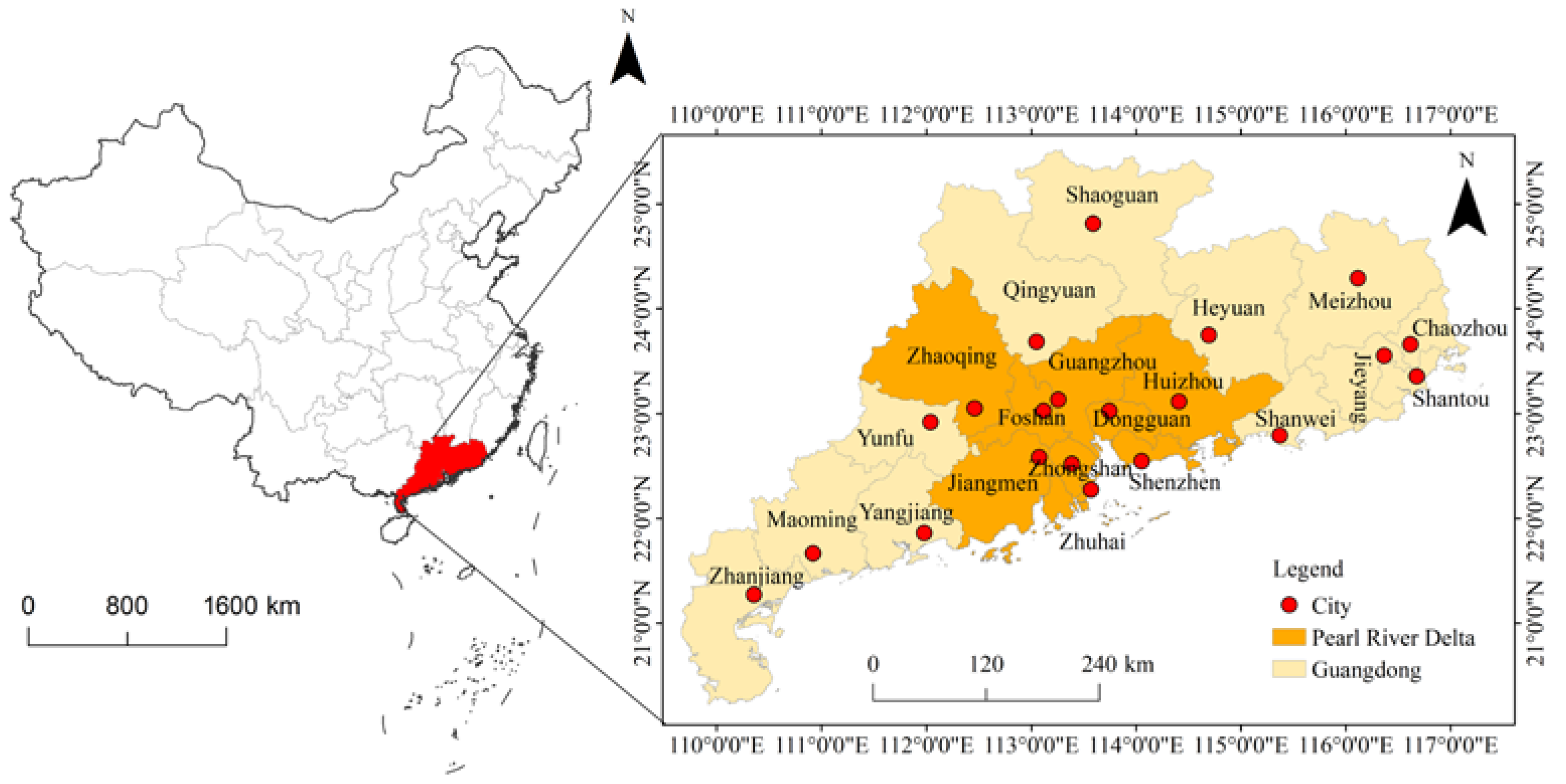
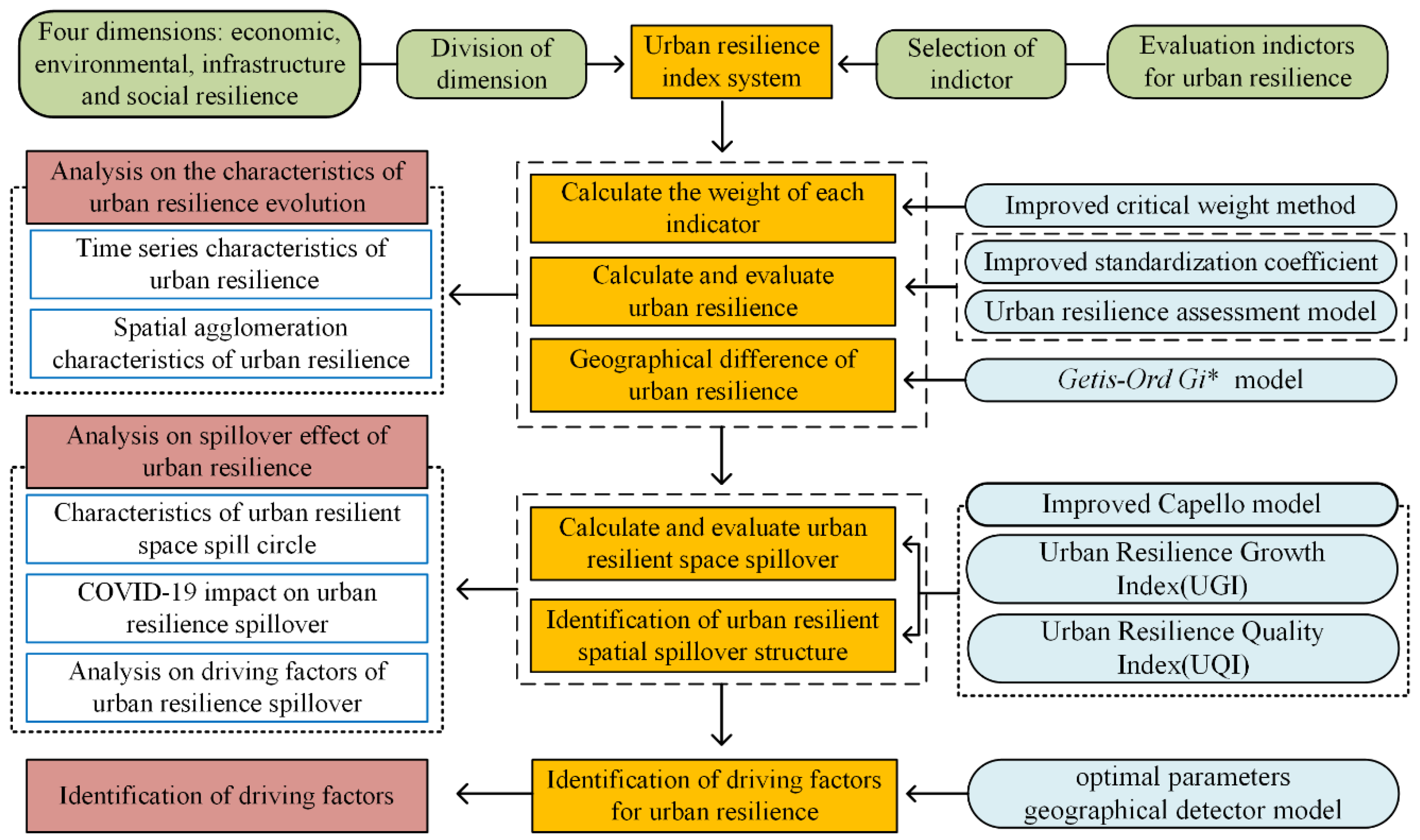
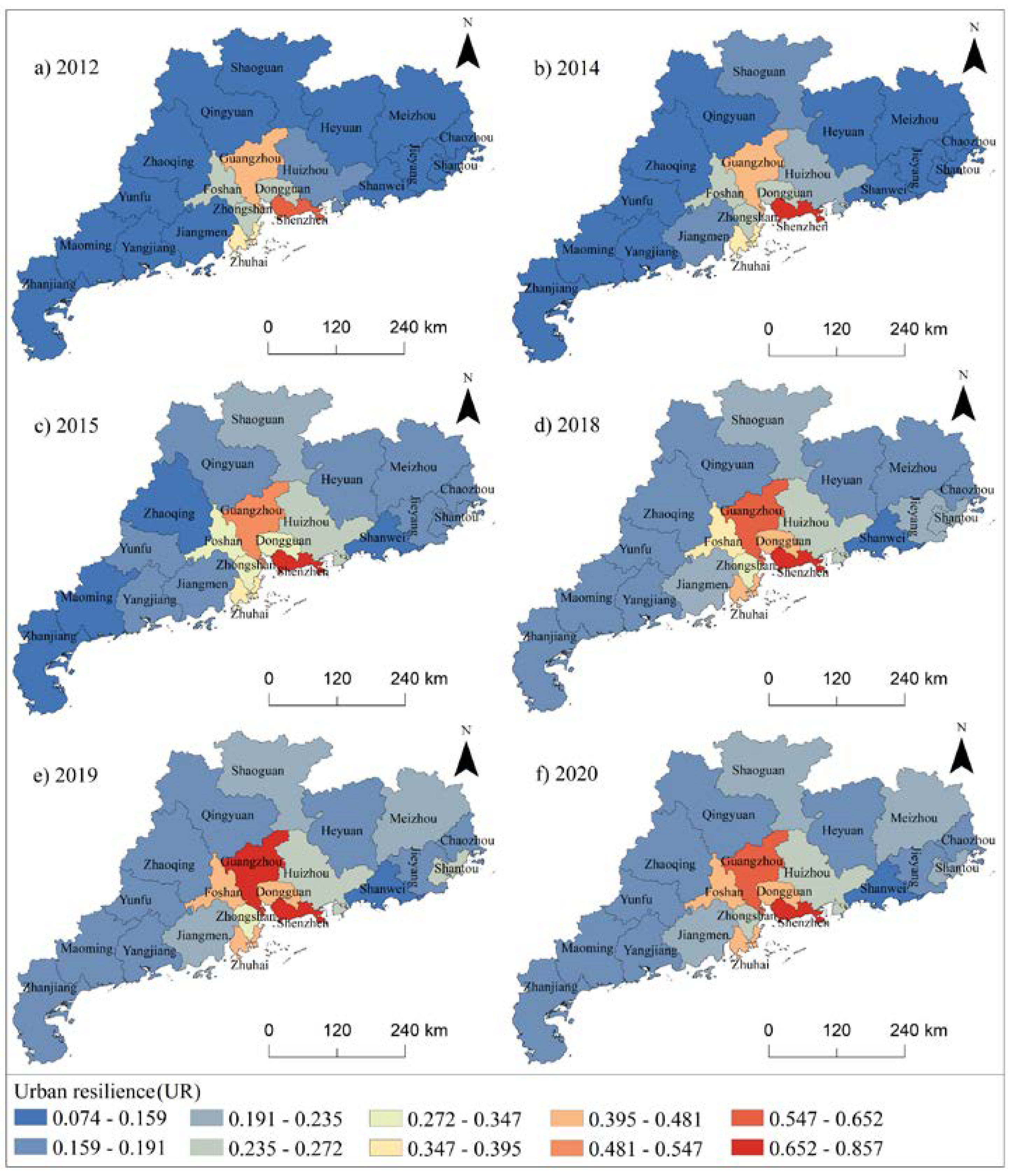
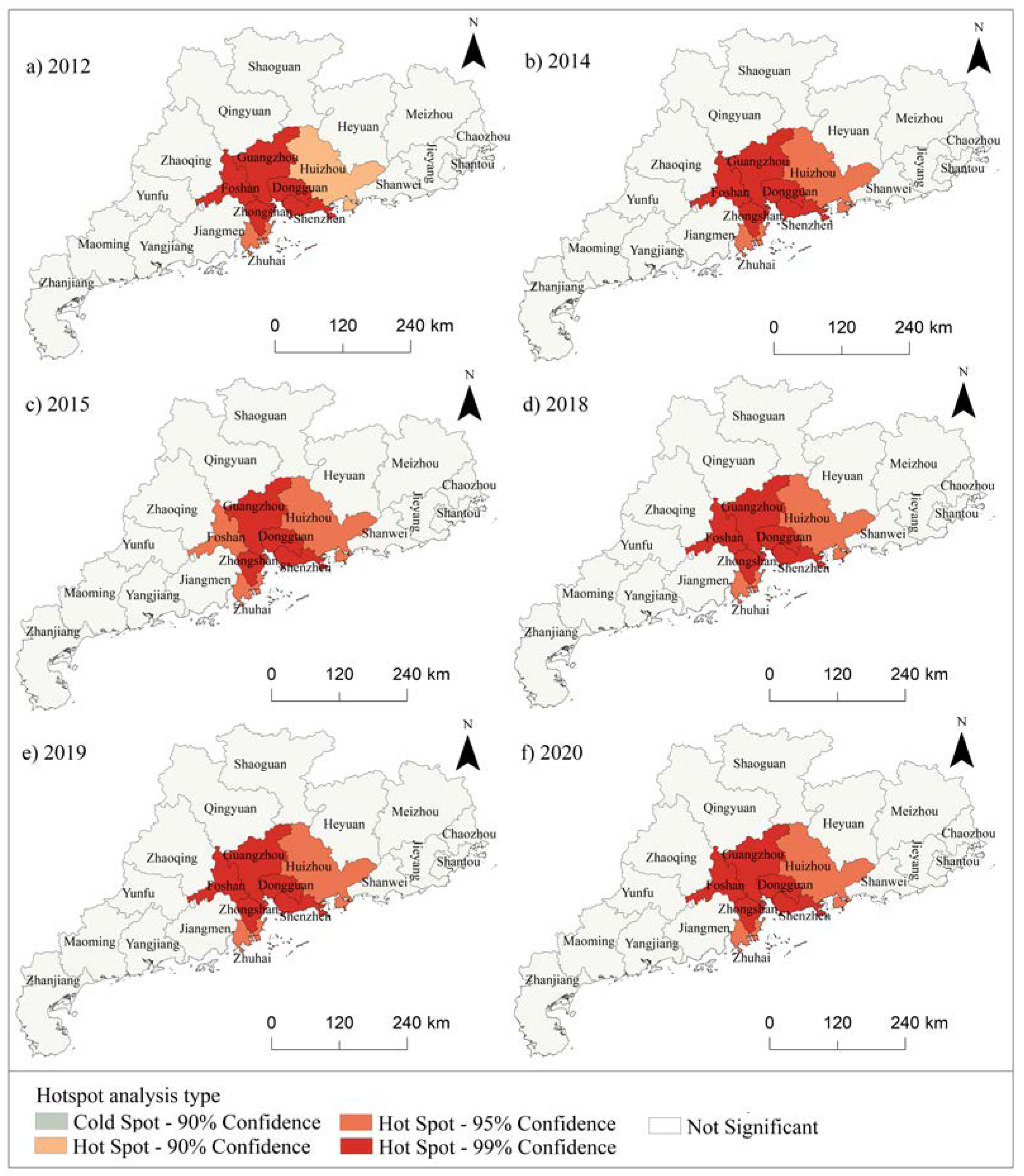
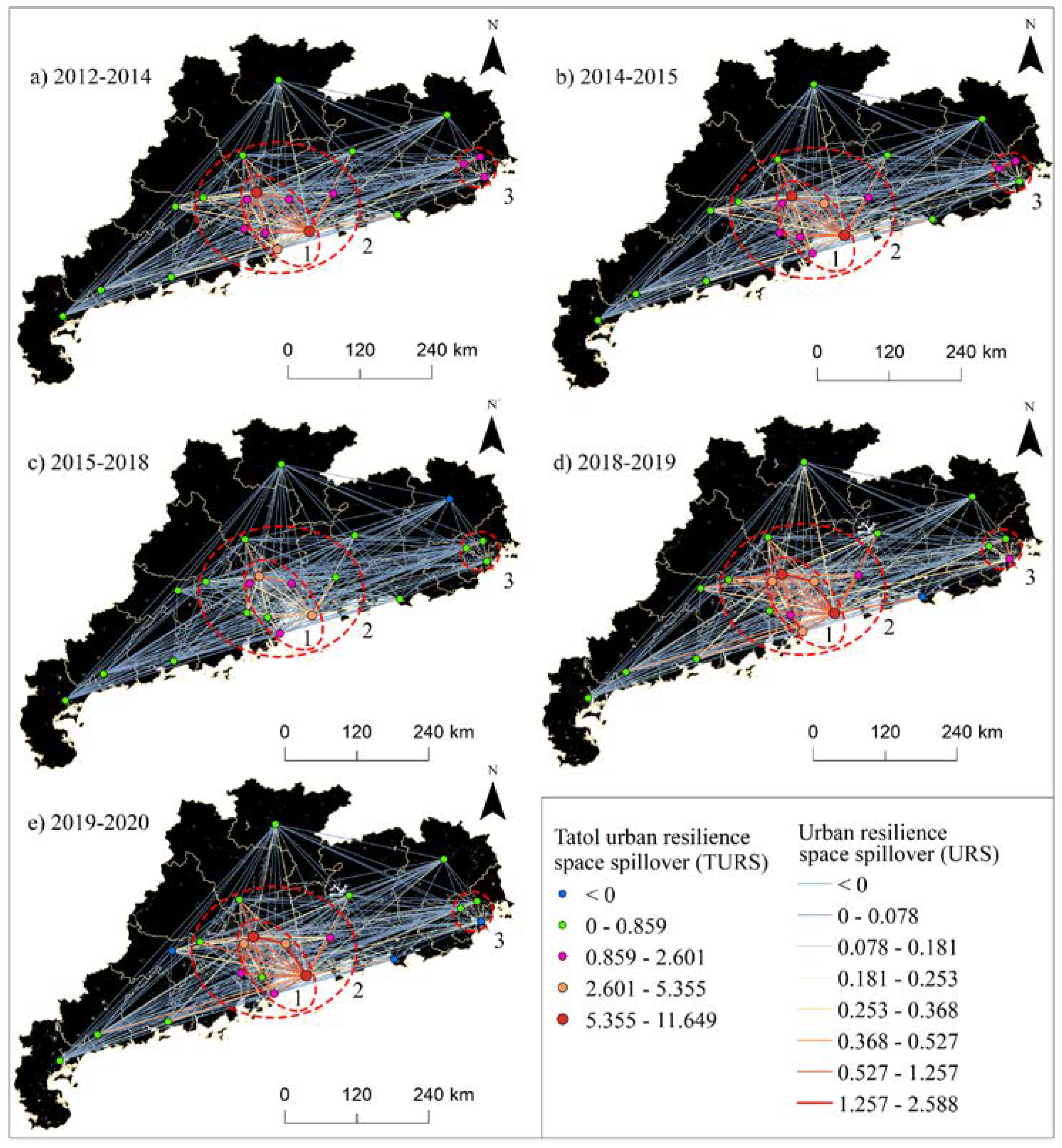
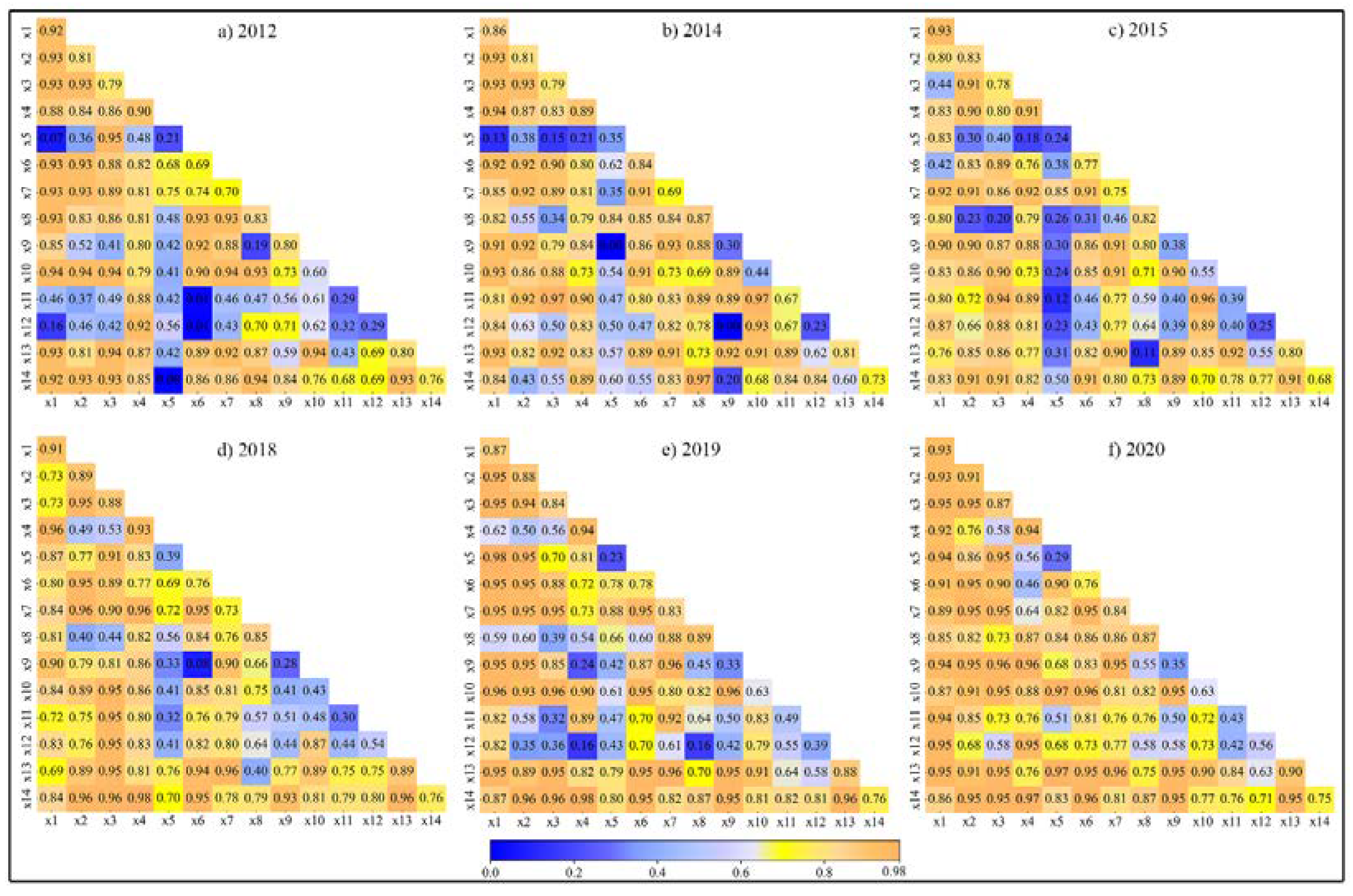
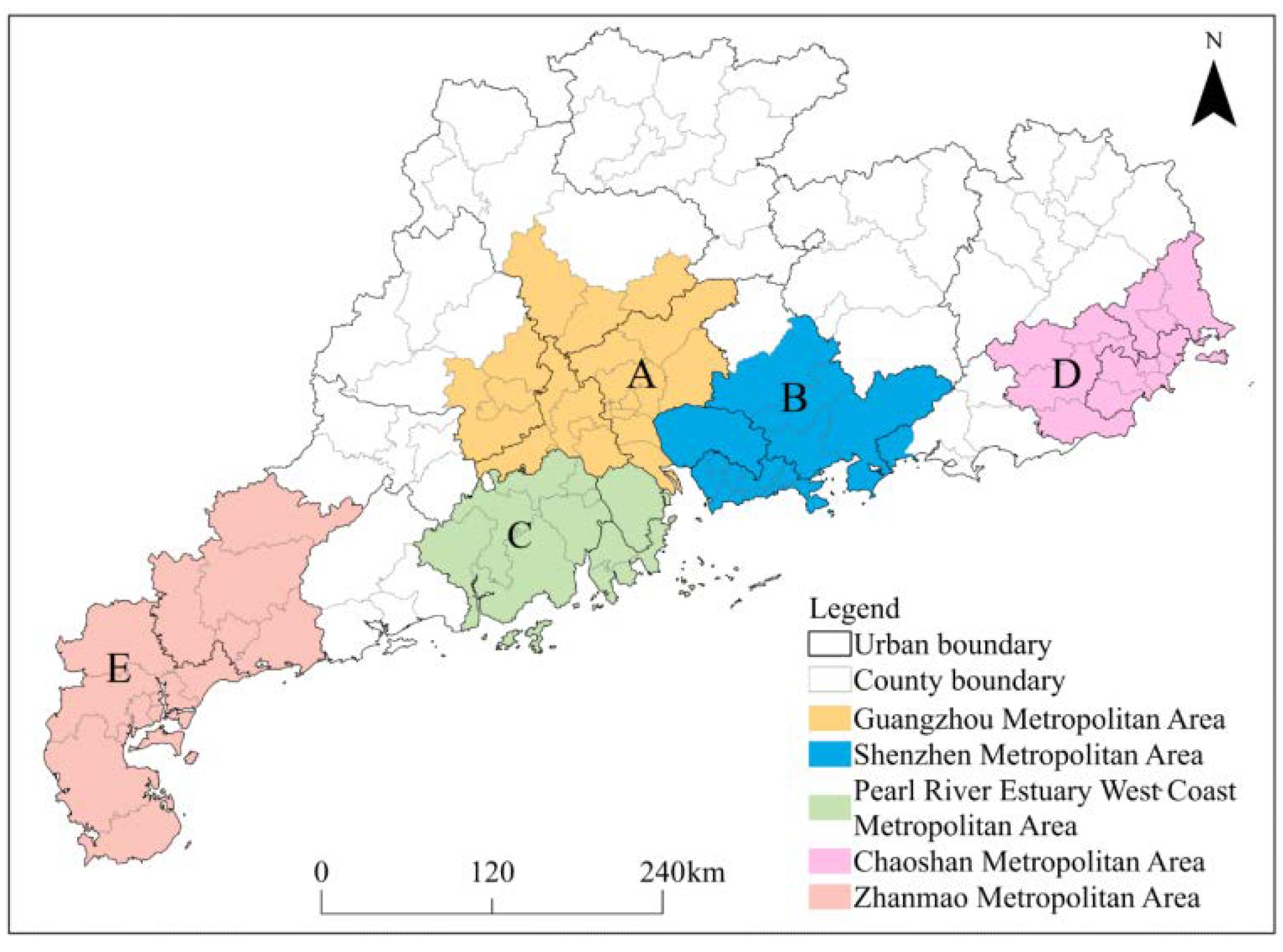
| Domains | Criterion Level | Indicators | Unit | Direction | Variable | Weight |
|---|---|---|---|---|---|---|
| Economic resilience | Economic foundation and capabilities (a) | Nighttime light density | DN/km2 | Positive | a1 | 0.0450 |
| Government expenditure | CNY 10,000 | Positive | a2 | 0.0527 | ||
| Number of urban large enterprises | Piece | Positive | a3 | 0.0433 | ||
| Total amount of urban social retail | CNY 10,000 | Positive | a4 | 0.0575 | ||
| Economic structure and stability (b) | Foreign investment as a percentage of urban GDP | % | Negative | b1 | 0.0097 | |
| Proportion of domestic enterprises | % | Positive | b2 | 0.0151 | ||
| Second industrial output | CNY 10,000 | Positive | b3 | 0.0461 | ||
| Ecological resilience | Ecological environment quality (c) | Proportion of green area to built-up area | % | Positive | c1 | 0.0078 |
| PM 2.5 concentration | μm | Negative | c2 | 0.0143 | ||
| Regional vegetation net productivity | gc/m² | Positive | c3 | 0.0225 | ||
| Slope | ° | Positive | c4 | 0.0271 | ||
| Proportion of water body area | % | Positive | c5 | 0.0448 | ||
| Urban flood vulnerability | % | Negative | c6 | 0.0209 | ||
| Urban purification capacity (d) | Urban sewage treatment rate | % | Positive | d1 | 0.0108 | |
| Total industrial wastewater discharge | 10,000 t | Negative | d2 | 0.0153 | ||
| Total urban sulfur dioxide emissions | 10,000 t | Negative | d3 | 0.0539 | ||
| Infrastructure resilience | Municipal facilities (e) | Number of buses per 10,000 people | per 10,000 people | Positive | e1 | 0.0670 |
| The total amount of urban freight transport | 10,000 t | Positive | e2 | 0.0496 | ||
| Road area per capita | m2/person | Positive | e3 | 0.0396 | ||
| Per capita power supply | kw·h/person | Positive | e4 | 0.0186 | ||
| Density of urban drainage pipes | km/km2 | Positive | e5 | 0.0647 | ||
| Social resilience | Social vitality (f) | Labor force unemployment rate | % | Negative | f1 | 0.0050 |
| Number of college students per 10,000 people | per 10,000 people | Positive | f2 | 0.0572 | ||
| Population growth rate | % | Positive | f3 | 0.0200 | ||
| Urbanization level | % | Positive | f4 | 0.0243 | ||
| Public healthcare (g) | Number of medical technical personnel per 10,000 people | per 10,000 people | Positive | g1 | 0.0167 | |
| Number of hospital beds per 10,000 people | per 10,000 people | Positive | g2 | 0.0186 | ||
| Social security (h) | Proportion of urban employee basic pension insurance contributors | % | Positive | h1 | 0.0167 | |
| Proportion of unemployment insurance contributors | % | Positive | h2 | 0.0337 | ||
| Proportion of employees’ basic medical care insurance contributors | % | Positive | h3 | 0.0123 | ||
| Proportion of work injury insurance contributors | % | Positive | h4 | 0.0322 | ||
| Proportion of maternity insurance contributors | % | Positive | h5 | 0.0371 |
| Driving Factors | Variable | Unit |
|---|---|---|
| GDP per capita | ×1 | CNY 10,000 |
| Urban GDP | ×2 | CNY 10,000 |
| Number of permanent urban residents | ×3 | CNY 10,000 |
| Proportion of primary industry | ×4 | % |
| Proportion of second industry | ×5 | % |
| Proportion of tertiary industry | ×6 | % |
| Number of higher education institutions | ×7 | Piece |
| Profit of all urban businesses | ×8 | CNY 10,000 |
| Total urban passenger traffic | ×9 | 10,000 people |
| Proportion of employed population in primary industry | ×10 | % |
| Proportion of employed population in secondary industry | ×11 | % |
| Proportion of employed population in tertiary industry | ×12 | % |
| Total balance of urban household deposits | ×13 | CNY 10,000 |
| Per capita deposit balance | ×14 | CNY 10,000 |
| Factors | 2012 | 2014 | 2015 | 2018 | 2019 | 2020 | ||||||
|---|---|---|---|---|---|---|---|---|---|---|---|---|
| Methods | Cn | Methods | Cn | Methods | Cn | Methods | Cn | Methods | Cn | Methods | Cn | |
| ×1 | Equal | 5 | Natural | 5 | Geometric | 5 | Geometric | 5 | Natural | 6 | Geometric | 4 |
| ×2 | Natural | 6 | Natural | 6 | Natural | 6 | Natural | 5 | Natural | 5 | Natural | 5 |
| ×3 | SD | 6 | Natural | 6 | Geometric | 6 | Geometric | 5 | Natural | 6 | Natural | 6 |
| ×4 | Geometric | 3 | Geometric | 3 | Geometric | 3 | Geometric | 5 | Geometric | 5 | Geometric | 5 |
| ×5 | SD | 6 | SD | 6 | Quantile | 6 | Geometric | 3 | Quantile | 6 | Equal | 6 |
| ×6 | Quantile | 6 | Equal | 4 | Natural | 5 | SD | 4 | Natural | 5 | Natural | 5 |
| ×7 | Quantile | 4 | Quantile | 4 | Quantile | 5 | Quantile | 5 | Quantile | 6 | Quantile | 6 |
| ×8 | Geometric | 6 | Geometric | 5 | Geometric | 4 | Geometric | 5 | Geometric | 5 | Geometric | 4 |
| ×9 | Geometric | 3 | Quantile | 6 | Quantile | 6 | Geometric | 3 | Quantile | 6 | Quantile | 6 |
| ×10 | Quantile | 6 | Quantile | 5 | Quantile | 5 | Quantile | 10 | Quantile | 5 | Quantile | 5 |
| ×11 | Quantile | 5 | Natural | 6 | Quantile | 6 | SD | 4 | Geometric | 5 | Geometric | 5 |
| ×12 | Geometric | 6 | Natural | 5 | Natural | 5 | Geometric | 4 | Natural | 6 | Geometric | 4 |
| ×13 | Natural | 4 | Natural | 4 | Natural | 5 | Natural | 6 | Natural | 6 | Natural | 6 |
| ×14 | Geometric | 6 | Geometric | 6 | Natural | 6 | Quantile | 6 | Quantile | 6 | Quantile | 6 |
| Factors | 2012 | 2014 | 2015 | 2018 | 2019 | 2020 | ||||||
|---|---|---|---|---|---|---|---|---|---|---|---|---|
| q | p | q | p | q | p | q | p | q | p | q | p | |
| ×1 | 0.923 *** | 0.000 | 0.856 *** | 0.001 | 0.933 *** | 0.000 | 0.911 *** | 0.000 | 0.870 *** | 0.000 | 0.927 *** | 0.000 |
| ×2 | 0.810 *** | 0.008 | 0.808 ** | 0.010 | 0.825 *** | 0.006 | 0.889 *** | 0.000 | 0.882 *** | 0.000 | 0.907 *** | 0.000 |
| ×3 | 0.786 ** | 0.014 | 0.785 ** | 0.016 | 0.775 ** | 0.013 | 0.883 *** | 0.000 | 0.843 *** | 0.003 | 0.870 *** | 0.001 |
| ×4 | 0.898 *** | 0.000 | 0.893 *** | 0.000 | 0.908 *** | 0.000 | 0.930 *** | 0.000 | 0.941 *** | 0.000 | 0.941 *** | 0.000 |
| ×5 | 0.212 | 0.846 | 0.349 | 0.724 | 0.238 | 0.794 | 0.386 ** | 0.008 | 0.226 | 0.662 | 0.293 | 0.694 |
| ×6 | 0.692 ** | 0.014 | 0.843 *** | 0.001 | 0.774 ** | 0.013 | 0.763 ** | 0.010 | 0.778 ** | 0.010 | 0.760 ** | 0.011 |
| ×7 | 0.699 *** | 0.005 | 0.693 *** | 0.007 | 0.748 ** | 0.010 | 0.732 *** | 0.005 | 0.832 *** | 0.002 | 0.837 *** | 0.002 |
| ×8 | 0.833 *** | 0.002 | 0.867 *** | 0.000 | 0.819 *** | 0.000 | 0.853 *** | 0.000 | 0.891 *** | 0.000 | 0.874 *** | 0.000 |
| ×9 | 0.803 *** | 0.000 | 0.297 | 0.473 | 0.377 | 0.330 | 0.275 | 0.079 | 0.327 | 0.410 | 0.352 | 0.365 |
| ×10 | 0.605 ** | 0.048 | 0.435 | 0.089 | 0.551 ** | 0.035 | 0.434 | 0.058 | 0.634 ** | 0.012 | 0.627 ** | 0.013 |
| ×11 | 0.286 | 0.376 | 0.669 | 0.084 | 0.390 | 0.348 | 0.305 | 0.413 | 0.493 | 0.051 | 0.427 | 0.067 |
| ×12 | 0.292 | 0.492 | 0.233 | 0.492 | 0.250 | 0.480 | 0.539 ** | 0.025 | 0.390 | 0.454 | 0.560 ** | 0.016 |
| ×13 | 0.799 *** | 0.004 | 0.805 *** | 0.004 | 0.799 *** | 0.005 | 0.887 *** | 0.000 | 0.877 *** | 0.001 | 0.898 *** | 0.000 |
| ×14 | 0.762 *** | 0.003 | 0.734 *** | 0.007 | 0.682 ** | 0.026 | 0.763 *** | 0.003 | 0.762 *** | 0.002 | 0.747 *** | 0.005 |
| Year | GD | PRD | Non-PRD | |||||||||
|---|---|---|---|---|---|---|---|---|---|---|---|---|
| USMax | USMin | USAvg | USSD | USMax | USMin | USAvg | USSD | USMax | USMin | USAvg | USSD | |
| 2012 | 0.651 | 0.078 | 0.189 | 0.139 | 0.651 | 0.100 | 0.291 | 0.163 | 0.144 | 0.078 | 0.113 | 0.021 |
| 2014 | 0.667 | 0.112 | 0.215 | 0.133 | 0.667 | 0.128 | 0.309 | 0.159 | 0.184 | 0.112 | 0.144 | 0.018 |
| 2015 | 0.809 | 0.131 | 0.250 | 0.158 | 0.809 | 0.143 | 0.358 | 0.192 | 0.209 | 0.131 | 0.169 | 0.020 |
| 2018 | 0.805 | 0.156 | 0.272 | 0.164 | 0.805 | 0.179 | 0.394 | 0.191 | 0.227 | 0.156 | 0.180 | 0.021 |
| 2019 | 0.856 | 0.149 | 0.285 | 0.180 | 0.856 | 0.177 | 0.419 | 0.208 | 0.241 | 0.149 | 0.183 | 0.026 |
| 2020 | 0.851 | 0.145 | 0.280 | 0.176 | 0.851 | 0.190 | 0.412 | 0.202 | 0.222 | 0.145 | 0.180 | 0.023 |
Disclaimer/Publisher’s Note: The statements, opinions and data contained in all publications are solely those of the individual author(s) and contributor(s) and not of MDPI and/or the editor(s). MDPI and/or the editor(s) disclaim responsibility for any injury to people or property resulting from any ideas, methods, instructions or products referred to in the content. |
© 2023 by the authors. Licensee MDPI, Basel, Switzerland. This article is an open access article distributed under the terms and conditions of the Creative Commons Attribution (CC BY) license (https://creativecommons.org/licenses/by/4.0/).
Share and Cite
Deng, H.; Liu, K. Spatiotemporal Evolution of Urban Resilience and Spatial Spillover Effects in Guangdong Province, China. Land 2023, 12, 1800. https://doi.org/10.3390/land12091800
Deng H, Liu K. Spatiotemporal Evolution of Urban Resilience and Spatial Spillover Effects in Guangdong Province, China. Land. 2023; 12(9):1800. https://doi.org/10.3390/land12091800
Chicago/Turabian StyleDeng, Haojian, and Kai Liu. 2023. "Spatiotemporal Evolution of Urban Resilience and Spatial Spillover Effects in Guangdong Province, China" Land 12, no. 9: 1800. https://doi.org/10.3390/land12091800
APA StyleDeng, H., & Liu, K. (2023). Spatiotemporal Evolution of Urban Resilience and Spatial Spillover Effects in Guangdong Province, China. Land, 12(9), 1800. https://doi.org/10.3390/land12091800







